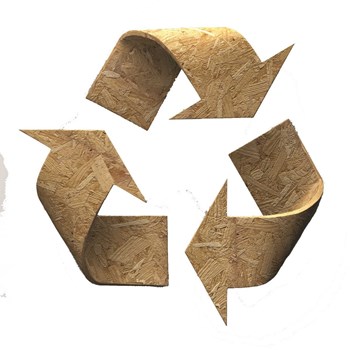
Tastes and styles change with the decades (and sometimes with just the seasons), and what is considered fashionable now may seem hopelessly dated in just a few years. This applies not only to clothing and interior design, but to architecture and building materials as well. As technologies advance and the 'green' movement continues, new building materials are constantly coming onto the market, and being incorporated by architects and contractors into both new construction and renovation projects alike. Once upon a time in Gilded Age New York, Mrs. Astor decreed that green was the color of the season. Green is back in style again.
Restoration Hardware
One trend that looks like it’s here to stay for the duration is the use of recycled, repurposed, or reused materials. The idea that a counter-top, say, has to be brand-spanking new is outmoded. Repurposing can be done with almost anything—including all the news that’s fit to print.
“For most of my jobs, I take insulation from other buildings and reuse it,” says Gennaro Brooks-Church, director of Brooklyn-based green building firm Eco Brooklyn Inc. “If I’m not able to do that, one of the products I like is cellulose. In this arena, that means the New York Times, shredded up, with a little bit of fireproofing added to it. It’s great insulation, and it’s a wonderful low embodied energy product.”
Resourceful repurposing works not only with newsprint, but also with harder materials as well. “I also reuse bricks and cobblestones,” Brooks-Church says. “The cobblestones of New York City were brought over from England as ballast in sailing ships. And they would throw them out here before returning home with the bounty of the Americas, so that’s why we have all these cobblestones here in New York. I use them for gardening and other things.”
Then there are the joists—the hardwood beams used to support the floors and ceilings of buildings. “We refer to the salvaged joists from New York buildings as ‘The Gotham Forest,’” Brooks-Church says. “There are billions of square feet of old growth wood that just doesn’t exist in nature anymore, and it’s been saved inside these buildings for over a hundred years. It’s just great stuff, and I make gorgeous counter-tops out of it, floors, furniture, shelving… just phenomenally beautiful, priceless stuff.” If it’s priceless, it must be expensive, right? Not necessarily, says Brooks-Church; “I get it out of Dumpsters.”
In addition to being recycled, these materials have the additional virtue of being found locally—even the cobblestones that originated in Great Britain have been here for hundreds of years.
“You used to be able to say that a product or material was energy efficient; now you can say that it’s energy efficient and locally sourced,” says Cameron Lory, senior project manager with Architecture Restoration Conservation PC in Manhattan. “You can pile on additional features to a single material. I think that’s an incredibly exciting thing, that you can know a lot about the overall costs of using a material in a way that you couldn’t before.”
The Best of the New
Amazingly useful as they are, not everything can be made out of old joists and last week’s Times. Fortunately, new products on the market have also embraced the green spirit.
With the restoration work that we do, the newer items for us are the pre-manufactured systems,” says Kyle Page, principal with Sundial Studios Architecture & Design PLLC in Brooklyn. “Like Hyload flashing, which is a flashing membrane system that has elements like pre-assembled corners. Areas that might be susceptible to insulation errors are pre-made, so they embed a bit more safety into the finished system. And it’s simpler for a solid system to be installed by a contractor.” Better insulation, of course, is 'green' in that it saves energy by holding in cool air in the summer and warm air in the winter. Insulation doesn’t sound sexy, but good insulation saves both money and energy.
“Most of it right now has to do with energy efficiency and ease of installation,” says Lory. “It’s about what we’re able to do with the materials. Where the really exciting new trends are is in our ability to keep water out of buildings, and the fact that we can do it in a way that’s incredibly efficient and long-lasting.” Again, there’s not much that's sexy about drainage, but good drainage is perhaps the biggest challenge in maintaining a building in New York. Where does rainwater go when it lands on the roof? Can it be drained more efficiently? Can its power be harnessed somehow? These are questions green designers and architects think about.
“Another material that we’ve used recently that we didn’t use three years ago is Jdrain,” Page says. “It’s a composite drainage mat that also has a mesh as part of it that keeps mortar from penetrating to the drainage plane. So it’s two or three systems put together that decrease the potential for insulation errors.”
Then there’s a whole other kind of green. “The products that I’m really excited about, as far as things that are new to the market, are hemp products,” says Brooks-Church. “They can be mixed in certain ways to create very strong concrete, they can be mixed in other ways to create a really good insulation. It’s a very fast-growing weed that’s cheap, and it doesn’t use up a lot of resources.”
So why doesn’t it get more play? Hemp “has a lot of potential, but it’s still held up as being classified as a drug,” says Brooks-Church. This too is changing however, as the residents of Washington and Colorado well know. It seems only a matter of time before hemp as a building product will re-emerge.
Green Inside
The choice of eco-friendly materials is not limited to roofs and walls. Remember when the granite counter-top was the hallmark of a glorious kitchen? That, too is changing.
“We haven’t used granite in a long time, and it’s not because of the cost,” says Kati Curtis, the principal with Kati Curtis Design in Manhattan. “The problem with granite is that it has to be sealed, and then there’s the concerns about radon levels that have cropped up in the last few years as they’ve been testing granite. And also the look - it’s very heavy, it’s very busy, it’s mottled.”
So what’s a person who wants an Architectural Digest spread for a kitchen to do? “We have pretty much standardized on Caesarstone or Silestone for countertops,” Curtis says. “These are conglomerate stones that are maintenance free, durable, and eco-friendly. You don’t have to seal them, and they last forever. People just love the ease-of-use and the clean look that they provide.”
The key word in Curtis’s comment: look. The most eco-awesome apartment in the Five Boroughs would not have much appeal if it looked like the inside of a birdcage. People want to go green…but environmental consciousness doesn’t trump sheer aesthetic appeal. “The green movement, as a marketing tool, hasn’t really flown,” says Curtis. “People want beautiful, amazing spaces, and I think a lot of what was touted as ‘green’ didn’t have the sex appeal, and it just wasn’t something people were as excited about.”
In fact, Curtis says the new color of the season may not be green at all, but something a bit more classical. “The biggest trend I’m seeing in interior design right now is using gold. It was big in the Eighties, and I would definitely say gold is coming back in terms of fittings and fixtures.”
The Future is Green
The financial incentives of going green—that is, making a building more energy efficient and eco-friendly—are by now well documented. This bottom-line savings makes even more sense in a residential building than it does in a detached home in the suburbs, as multiple families living in one building, sharing resources and splitting many of the associated costs is an inherently 'greener' living arrangement. As the costs of products and materials go down, this is likely to continue trending upward in the years ahead.
But, as Curtis has seen, being green and looking green are not one and the same. “Clients want to create really gorgeous interiors that don’t look typically ‘green,’ and do it in a way that’s safe,” she says. “A lot of our clients have young children with chemical sensitivities, or pets. They want to create a healthy environment, but they want a glamorous lifestyle at the same time.”
Is it possible to combine the two, to have an apartment that's ready for its Architectural Digest close-up, that is also green? That is the challenge. “There’s no excuse to not be able to create an amazing environment that’s also healthy,” says Curtis. “Problems arise not so much with materials, but what’s added to the materials. In furnishings, it’s the wood glues, particle board… you want both to have no formaldehyde. And the finishing materials: are you using a low VOC lacquer vs. an alka-based lacquer? These are the kinds of questions we’re asking.”
Sometimes this means deconstructing the whole idea of how to put a building together. “I try to get away from products, period,” says Brooks-Church. “It’s not about the product, it’s about the raw material. The moment you can get away from the product, you stop being a consumer, and that right there is a massive step.”
Greg Olear is a freelance writer and frequent contributor to The Cooperator.






Leave a Comment